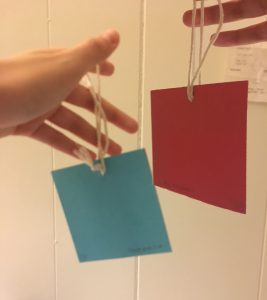Pressure Project 3
Posted: December 15, 2016 Filed under: Uncategorized Leave a comment »For the Pressure Project 3 I used 2 colors as a dice to activate different interactivity modes. Firstly I created a square shaped, paper, two sided (red & blue) colored dice on a piece of string.
I introduced the dice to the viewer and asked her to experiment with it by showing it to the camera. In order to see the “trick” she needs to match the right side of the camera and the dice. I divided the screen in two half with the crop object and assigned red or blue colors to each side. Blue is tracked only on the left side of the camera/ screen and red is only on the right.
Blue color activates a different sound and blue visuals also the color picker triggers a type object that indicates “ “ in addition to a whisper soundtrack on the background. Red color activates a jackpot! İllustration with a changing scale based on the movement value and a clap soundtrack in order to indicate the “win”.
I used the dice as a symbolization of two different image and sound results that are presented to the viewer. Red symbolizes a winner theme while blue symbolizes a random/neutral trigger with the murmur and whisper sounds on the background. I tried to use blue for keep trying to find the right side and red as a finish point of the game (with a win). It seemed to work on the audience. They found both red and blue sides.
I tried to come up with a simplistic dice idea in order to enable the motion and flexibility of the object in front of the camera. Color code seemed to work well, which is an important feature to use/learn in visual programming. Also in addition to using chroma key object, I used inside range and measure color object for the first time. Measure color object works great, especially for measuring the exact numbers of RGB pixel values. I am surprised how much I learned from a dice concept. A dice can be anything that triggers different functions.
Here is the Isadora file: karaca_pp3-izz
Two sided paper dice
Video is captured from the screens perspective, so when we see red side of the dice on the video, camera recognizes the blue and vice versa for red.
